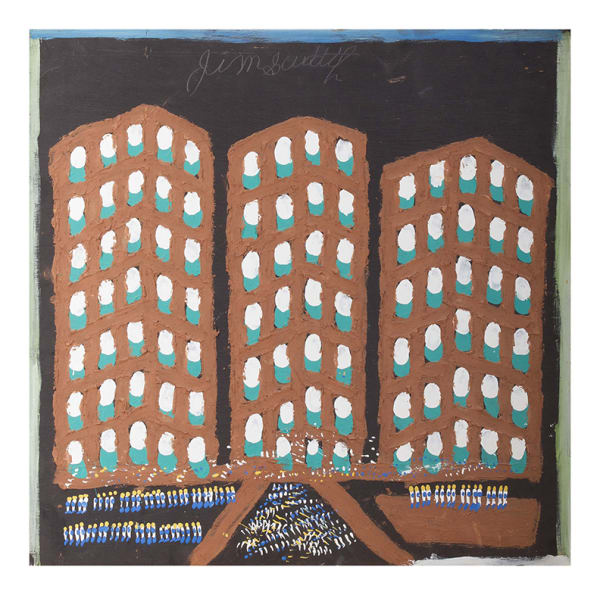Jimmy Lee Sudduth American, 1910-2007
Jimmy Lee Sudduth extracted many of his pigments from nature and preferred to paint with his fingers rather than brushes. In his art he celebrated and re-created the world around him, representing the local architecture of his hometown of Fayette, Alabama, iconic American landscapes and symbols such as the New York City skyline and the Statue of Liberty, people he knew, self-portraits as a musician (he was an accomplished harmonica and banjo player), and animals, including his beloved dog Toto (of which there was a succession after the first Toto died). Sudduth grew up on a farm in Cains Ridge (near Fayette) with his adoptive parents, itinerant farm laborers. His mother was part Native American and a practitioner of herbal medicine, and she would bring him along from a very early age on excursions into the woods in search of medicinal flora. Sudduth’s earliest memories included painting with mud on a tree when he was three years old, and he credits those sojourns in the woods as the catalyst for his impulse to use natural tinctures.
Sudduth spent most of his life working on farms, at a grist mill, and at a lumber mill. In the 1950s he also worked as a gardener and handyman. After the death of his first wife in 1941, with whom he had a daughter, he remarried. He and his second wife adopted a son and were together more than thirty years until her death in 1992. Sudduth lived in a small house near a railroad track, where he painted and played the blues on his harmonica. As a mature artist he started working with house paint and acrylic but kept exploring the expressive potential of mud and its ochre gradations. First tracing a composition on a scavenged wooden surface with a soft stone that he referred to as a “dye rock,” he would apply a layer of mud and add more colors from organic matter (wild berries, grass, coffee, and soot) mixed with binders (syrup, sugar, soft drinks, and caulk). Sudduth never learned to read or write but he could “draw” his name on his finished works.
Although he became diabetic and suffered bouts of pneumonia in the last years of his life, it was not until he was placed in a nursing home that he stopped painting and died some months later at the age of ninety-seven. Sudduth’s first exhibition was held in 1968 at Stillman College in Tusca-loosa. A 1971 exhibition of his work at the museum in Fayette’s City Hall Auditorium was organized by Jack Black, a Fayette businessman and local newspaper publisher, who became Sudduth’s longtime friend and an early supporter. Sudduth was selected to represent Alabama in the Smithsonian Institution’s Bicentennial Festival of American Folk Life in 1976. The Birmingham Museum of Art exhibited his paintings in 1978 and he appeared on The Today Show and 60 Minutes in 1980. In 2005 a solo show of his work was organized at the Montgomery Museum of Fine Arts, with a catalogue, The Life and Art of Jimmy Lee Sudduth.
Sudduth’s work is in the collections of the African American Museum (Dallas), the American Folk Art Museum (New York), the Birmingham Museum of Art, the Fayette Art Museum and the Montgomery Museum of Fine Arts (Alabama), the Milwaukee Art Museum, the Mississippi Museum of Art (Jackson), the Smithsonian American Art Museum (Washington, D.C.), and the New Orleans Museum of Art.








